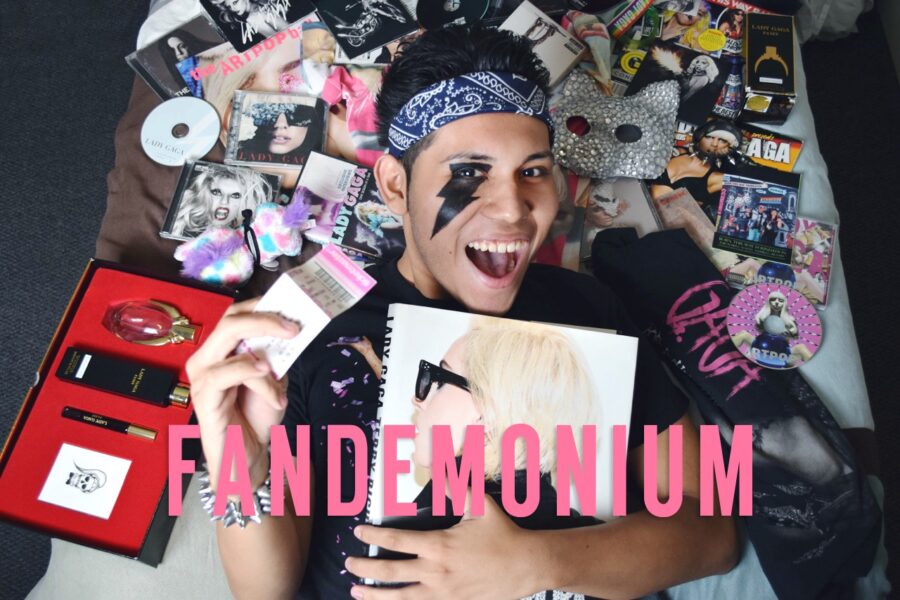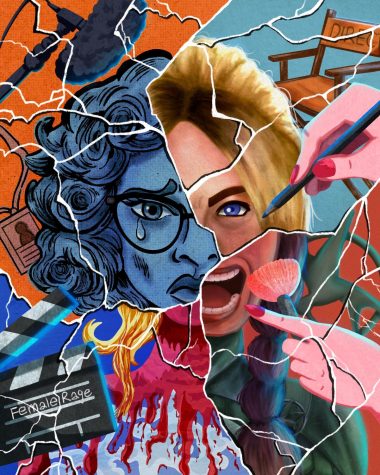A look into the mad life of fangirls and fanboys
It’s their own world. We just live in it.
Story by Jennifer Sandy, Daney Casas, Albert Serna Jr., and April Jimenez
The clock strikes 10 and you cringe knowing it’s going to be another sleepless night. For as long as you can remember, you have performed the nightly ritual that fangirls everywhere have been doing. Countless hours dedicated to searching for concert videos, refreshing your Twitter feed, and editing a blog dedicated to the boy band you idolize. You cannot sleep knowing you might miss a new song leak, or live streams that are in a different time zone, or some new information that you can share on your update account. Doing your homework, studying for a test, or even waking up early for your 8 a.m. class is again out the window. You finally succumb to oblivion at around 5 a.m., but the members of the band keep you company by staring back at you from your computer screen.
Actors, musicians, athletes and even comic book superheroes and video game characters all have one thing in common—fanatics. These are the fans who take their admiration to the next level. They are called fangirls and fanboys. It’s the sci-fi enthusiasts who never fail to dress up for Comic-Con and attend midnight premieres, Twi-hards who have gone through dental cosmetic surgery to achieve vampire fangs, Potterheads who know every story line and spell and have tattooed the Deathly Hallows symbol on their bodies, or Beliebers who stayed true to the Biebs despite the DUIs. These are just some of the fangirls and fanboys of today’s culture.

The stages of fangirls/fanboys
Fangirls and fanboys have been described as obsessives, maniacs, and even stalkers, but the fervor that unites them may originate in the brain. Psychology Today reported in 2011 that humans are hardwired to become attached to outside entities. The brain’s mesolimbic system functions as a link between the two chemicals which are responsible for liking and wanting. When one is triggered, the other is triggered, and it leaves us wanting what triggered them again. Because the two are connected, when they are triggered it can be addictive. While these feelings are usually reserved for things like food, there are things that can trip up the circuit. “For fanatics, liking may trigger an unusually high degree of wanting,” said Jeff Rudski, a psychologist at Muhlenberg College.
For some fans, like Veronica Grant, a 27-year-old graduate in communications from California State University Fullerton who has been part the *NSYNC fandom for nearly 20 years, it was the band’s music that hooked her. Grant said that she joined the fandom because she was able to relate to the music’s meaning. “I like the music and can relate to the life story of the band. My birthday also follows on the day the band created itself,” said Grant.
Alex Mundo, a 19-year-old business major at Mt. San Antonio College in Walnut, Calif. (pictured above) has been a Lady Gaga superfan since he first heard her single “Bad Romance” on the radio in 2008. “She got popular during a time when the radio was dominated by rap and hip-hop. Her sound was just so different,” Mundo said.
Mundo is a part of the LGBT community, and he said that part of what drew him to Gaga was the message within her lyrics. “I wasn’t really out to people at the time,” Mundo said. “And Lady Gaga’s just always telling her little monsters to be themselves. It’s super encouraging.”
Mundo credits Gaga with giving him the courage to come out and shape his personality into what it is. He said that without her he may never have become the person he is today.
“I fell in love with her,” Mundo said. “She just doesn’t care what anyone thinks and that’s exactly what I needed at the time.”
Songs like “Born This Way” and “The Edge of Glory” give Mundo the courage to continue to be himself. Mundo owns all of the Gaga merchandise pictured above, in addition to every CD she has recorded, and he has attended three of her concerts. He said that being a “little monster,” as Gaga fans are called, is easy because Gaga has such a personal relationship with her fans. “She has a relationship with her fans that’s unlike any other star out there,” Mundo said. “She’s so great. She makes us feel as if we’re all special in our own way.”
While many young and not so young people have a mild obsession with pop culture celebrities, there are some who find this over-the-top obsession unhealthy. “Engagement in a devotee world isn’t inherently harmful,” said Rudski. “But for some, the object of devotion begins to substitute other rewards in life.”
In a Vulture.com article, Dr. Drew Ramsey, a Columbia professor of psychiatry and co-author of The Happiness Diet, believes that fan admiration can become unhealthy when the obsession moves beyond what is considered a normal interest. For example, he sees patients whose marriages are in jeopardy because of a partner’s obsession for NFL Sunday, which demands hours of television-watching each week. “I believe in leisure, but we’ve sort of swapped out something that is supposed to be pleasurable and leisurely and replaced it with an intense involvement,” Ramsey said.
You know you’re a fangirl/fanboy when …
First, you discover them. They pique your interest because maybe their musical sound is different, or they look cute, or they have the whole package and are incredibly appealing. Or perhaps you dislike them at first, but then out of the blue they start to grow on you. Gradually, you start incorporating them into your daily life. You listen to them on the radio and blast them from your car, or read every article written to learn bits and pieces of information you did not know before, and soon you are following them on every social media platform available. The obsession continues. You’re spending money on posters from magazines that you can decorate your walls with and merch that you would not mind being seen in public wearing. You start developing a new kind of relationship with your idol and sometimes find yourself daydreaming of them. You gaze into space and begin to picture scenarios that are fan-fiction worthy. You have now dipped into a deeper level than just being a fan. You have gone public and proclaimed your love on your bio on every one of your social media sites. You are planning to go to every single event that is in your area, or even out of your area. This is when the stalking starts. You follow update accounts that can give you information and sign up as an insider as well. You do not even notice how much time, gas or money you have spent on your idol because all you want is to meet them.
Jadrienne De Leon, a 19-year-old who attends Bethesda Christian University in Anaheim, Calif., was working at the Rose Bowl during one of One Direction’s three sold-out shows in September 2014. “I have never seen so many diehard fans at a concert before,” she said. The lights dimmed and suddenly the stadium was pitch black. Then five of the most desired young men appeared on stage and the fans let out a roar unlike anything else. De Leon said there was an obvious love and dedication that united all 60,000 fans at the venue. She described the scene: “All the fans actually resembled one another in some way. They all reacted the same when walking into the stadium, whether in floor seats or the worst ones, they were happy to be there. They all dressed in one of maybe four outfits and there was always a wild colorful outfit, and they also all screamed the same … which was loud. I was wearing earbuds to protect my senses but I could still perfectly hear the concert followed by the raging screams of fan girls and boys.” Fans of One Direction are known to either dress like they just came out of a Brandy Melville catalog, the streets of London, or in head-to-toe band merchandise.
Social media is changing the game
Today’s technological advances and social media has revolutionized the way fans interact and meet their favorite artists. However, it is the boy bands who have garnered the craziest fan followings. One Direction, whose fans are known as “Directioners,” is the biggest boy band of today’s generation and their supporting band, 5 Seconds of Summer, is right behind them. Pop culture writers have compared these audiences to fans reminiscent of the The Beatles in the 1960s. Buzzfeed even did a comparison of the two groups of fans, asking readers to decide which fans were the craziest.
But fans of the Beatles did not have the technological gadgets that fans today have, such as smart phones. These handheld devices allow fans to pass along information from person to person in seconds. Twitter has become the Mecca for following—or stalking—celebrities. On Twitter, there are update accounts managed by fans that give exclusive updates to fans all over the world by helping the fan base meet their favorite people through insider information. Becoming part of an update account is an extensive process. Choosing co-owners and insiders require several applications and trial periods to ensure the source of information is reliable and consistent.

Larisa Lopez, a 21-year-old from Calexico, Calif. and student at the University of Phoenix, lives four hours away from Los Angeles and co-owns @5SOSWWReports, a 5 Seconds of Summer update account with 93,000 followers with four other admins.
“We usually work together with our insiders to help them find the boys. Therefore, it not only benefits them, but it also benefits us as an account. We are able to give our followers information, but not too detailed information. If they’re in another country, we of course do the best we can to navigate them around to the possible places the boys may be.”—Larisa Lopez, @5SOSWWReports
Time management is a big obstacle that fangirls/fanboys have to overcome. Since they spend more than the average time online, they need to prioritize and learn how to manage their personal lives. “School and work always come first,” Caitlyn Fong, a 17-year-old Glendale Community College student in Los Angeles and co-owner of @5SOSWWReports, said. “I’m usually on Twitter during my free time, which is usually during my breaks. There are five of us on the update account so someone is always online. This really helps because there isn’t so much stress on one person to constantly be online all the time updating. It’s honestly not that hard balancing it out.”
Youth is also a factor. Nikkia Bobongie is a 16-year-old high school student from Australia who co-owns @1DUpdategirls, a One Direction update account. She has never personally met her fellow co-owners in person because she lives on the other side of the world, but said she is surprised that people her co-owners’ age would have time for such pursuits. “I have never met the people who help run the account with me. Most of them are older than me now so I would assume they’d be mature, in college and ready to move on into the big world. Sometimes I wonder how they can even still manage to help run the account—they seem too old.”
Fan obsession has also taken flight on Tumblr, where fangirls and fanboys gather and make pages in dedication to their Gods. Post after post, visitors can get to know a band extensively. As if posting pictures isn’t enough, these fans go the extra mile to customize and edit photos, making their idols look a certain way. Another form of editing is syncing pictures together, whether it be a before and after or the blending of two people in one.
Although fandoms sometimes get a bad rep, fangirls and boys say there are more good things than bad when it comes to being in a fandom. There is always a support group that is always right there, and this common bond often leads to cross-global friendships. Abigail Jimenez, a 16-year-old who lives in Los Angeles, has a Twitter friend in Australia who she constantly Snapchats with. They plan to meet up when she visits Los Angeles this year in December. “Alana is a really good friend,” Jiminez said. “She has been there for me since the start and helped me get through the death of my mother. It’s weird to think that liking the same band has brought me to meet one of my best friends.”
OTP and shipping
Fans also have couples they obsess over and hope to see together. In Internet slang, a person’s favorite pairing of people or characters is called an OTP, or One True Pairing. Whether it be Rachel and Ross from Friends, Carrie and Mr. Big from Sex and the City, Ron and Hermione in Harry Potter, or Rachel McAdams and Ryan Gosling in The Notebook, fans are usually guilty of having at least one. OTP shipping (internet slang for the act of pairing characters into romantic relationships, popularized in fanfiction circles) is a testament to the undeniable chemistry fans see between two people that fuels their desire to see them together forever. Fangirls tend to take everything to the next level. They like to create their own relationships with the band members within the band that can sometimes hurt real-life ships.

Fangirls will go as far as to create conspiracy theories of band member’s girlfriends acting as “beards” to conceal the real relationships, creating YouTube videos with “proof,” and creating elaborate stories on fanfiction sites such as Wattpad that gather a huge following. Other fans even ship people and characters with themselves. TV personality psychologist Phil McGraw looked into the romantic side of celebrity fandom worship when he had a guest on his show who fantasizes day and night about Brad Pitt in hopes of one day meeting him, or even better, marrying him. She has so much Brad Pitt memorabilia that her home has become a shrine to him. Mc Graw suggested that she put more energy into dating or pursuing a realistic goal. That way, she won’t set herself up for disappointment if she never becomes “Mrs. Brad Pitt.”
Merch, toys, and empty wallets
A big part of fandom is the merchandise. Fans will sometimes go to extremes when it comes to unloading their wallets on their favorite idol’s memorabilia. Even parents sometimes give into their fan kid’s obsessions. Take Rosie Guzman, a 43-year-old restaurant manager in Los Angeles who once waited hours in line outside the crowded streets of Sunset Boulevard to help her 14-year-old fangirl daughter and her friends secure a spot outside The House of Blues to get tickets to see a 5 Seconds of Summer show. Guzman has spent at least $2,000 on band merchandise and said there is no way she can refuse her only child’s request. “I do this because I know she will get depressed and therapy costs too much,” said Guzman.
Like so many people in fandoms, *NSYNC fan Grant has gone about gathering merchandise, souvenirs, and collectables that the band has released.
“There are very few things that I don’t own. It’s mainly props from the shows, gold, platinum records. I could fill three rooms in my house with the merchandise I have.” — Veronica Grant
Grant’s devotion to the band has also led her to attend their shows whenever possible, including three concerts on three separate tours. Unlike other fanboys and fangirls, Grant does not talk much to other fans about her dedication, and said she believes that some fans go too far in their admiration. “I never talk to other people who like *NSYNC as much a I do. I do follow blogs of fans, as they have updated information. But many have been reached out to by the band’s management as they crossed the line and invaded privacy.”
And fandoms sometimes do cross the line. Singer Justin Bieber’s former girlfriend, actress and singer Selena Gomez, watched 20-year-old Che Cruz, get arrested hours after his release from jail for stalking her the previous month in 2014. In 2013, during the Australian leg of their tour, a fan climbed into One Direction’s balcony, made their way into band member Liam Payne’s room, and stole his boxers while he was asleep. Payne tweeted: “Strangest way I’ve ever been woken up, When ur in bed butt naked an sum1 is trying to force open your balcony, this is gunna be a strange day.”
Clint Van Zandt, a former FBI profiler, told the UK tabloid the Express in a June 2014 article that celebrity stalking is on the rise thanks to social media. “Celebrities today are exposed more, on social media and in an array of media outlets,” Van Zandt said. “Every celebrity Facebook and Twitter post removes a layer of safety and gives a stalker more opportunity to feel some connection with a celebrity.”
Is it really okay to know a famous person’s every move and invade their privacy? Some say no. But for fangirls and fanboys, it is not just about being a fan. It is a lifestyle.
Header photo of Alex Mundo taken by Adam Ernesto Fuentes
Substance is a publication of the Mt. San Antonio College Journalism Program. The program recently moved its newsroom over to Medium as part of a one-year experiment. Read about it here.










